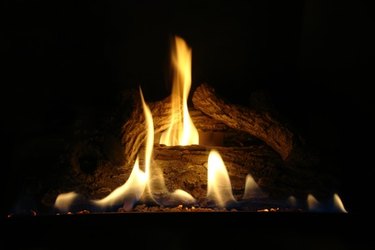
You’re relaxing in front of the fireplace or gathered around the cozy wood stove when big clouds of smoke start spilling out. If this happens only on windy days, the problem is called “back puffing.” While woodstoves and fireplaces are warming on cold winter days, they do require regular maintenance in order to operate properly. The solution to the "back puffing" problem is as simple as installing a chimney cap.
Cause of Back Puffing
Video of the Day
Back puffing is usually due to wind that is deflected off taller trees or buildings, nearby hills or mountains and directed down your chimney. This wind-induced downdraft will cause smoke to puff out of your fireplace or woodstove. The draft can make it difficult to light a fire and may even blow it out. There are chimney caps scientifically designed to handle this problem.
Video of the Day
How A Chimney Cap Works

The chimney creates an opening into your home and should have a cap. Whether your chimney leads to a wood burning stove or a fireplace, it directly affects performance. The chimney cap keeps out rain and snow and, when installed properly, will stop wind from blowing down into your home, creating smoke and cold drafts. If the downdraft problem is severe, consult a chimney specialist. He may install a special downdraft deflector cap. Some caps have a baffle system with wide bands of metal that curve up over the chimney top to redirect the wind. The cap may increase the chimney updraft, improving performance of the woodstove or fireplace.
Chimney Cap Construction

Caps are made of different types of metal, but those constructed of copper and stainless steel are more durable. Caps often have a screen mesh incorporated to keep out squirrels, birds, mice and rodents. Masonry chimneys may have brick, stone or concrete caps raised above the top of flue on stone or brick legs. Factory-built chimneys usually have a cap incorporated into their design.
Benefits of Using a Cap

In addition to preventing "back puffing," chimney caps increase the efficiency of your fireplace or wood stove and decrease cold drafts. They keep out birds, small animals and prevent chimney blockage from debris or nests. By keeping out rain and snow, they prevent moisture buildup in the flue.
Some Types of Chimney Caps
Vacu-Stack Wind Resistant Cap As the wind blows around cap, it creates a partial vacuum, pulling flue gases up the chimney, preventing downdraft and release of smoke and gases into your home. An adaptor is needed to install it on a square or rectangular chimney.
Draft Master Cap This cap has passages to handle vertical winds, providing maximum updraft, forcing air inside chimney to move upward toward the opening. This is a high performance chimney cap, scientifically engineered to principles of wind pressure and velocity.
FAMCO Wind Directional Cap This cap rotates with wind direction, creating a partial vacuum in flue, creating an updraft which prevents back puffing.
Air Manager Cap This smaller cap is ideal for gas fireplaces, gas water heaters and other gas appliances. It isn’t suitable for heavily smoking chimneys.